2. 东华理工大学地球物理与测控技术学院, 南昌 330013;
3. 南方科技大学海洋科学与技术学系, 深圳 518055;
4. 海洋科学与技术国家实验室海洋地质研究所, 青岛 266071
2. School of Geophysics and Measurement-Control Technology, East China University of Technology, Nanchang 330013, China;
3. Department of Marine Science and Engineering, Southern University of Science and Engineering of China, Shenzhen 518055, China;
4. Laboratory for Marine Geology, Qingdao National Oceanography Laboratory for Science and Technology, Qingdao 266071, China
地球磁场时空特性的研究需要对地球磁场的长期变化进行观测(Merrill and McElhinny, 1983; Zhu et al., 2001),然而地磁场的直接观测仅仅有四五百年的历史(Stern, 2002).随着研究的深入,人们发现地球磁场信息能够被岩石和沉积物内部的磁性矿物所记录,因此使得地质时期的地磁场信息提取成为可能(Butler, 1992).例如,通过古地磁学方法精确分析岩石矿物中的磁记录,可以将地磁场的起源追溯到42亿年以前(Tarduno et al., 2007; Tarduno et al., 2015).时至今日,古地磁学已经发展成为定量解决地球内核流体运动,板块构造和古地理重建等重大地球科学问题的必要手段.随着磁学理论的发展,环境磁学、生物磁学等一些新兴地学学科也逐步发展了起来(Blakemore, 1975; Thompson and Oldfield, 1986).
从岩石或沉积物中提取可靠的剩磁信息是古地磁学、环境磁学和生物磁学的研究基础,并直接影响人们对于地核发电机理论、板块构造等深层次地球科学理论的解释.因此有必要对岩石或沉积物进行磁学研究(即岩石磁学,图 1),即分析磁性矿物的物理、化学性质,研究矿物的微观结构特征对岩石或沉积物磁学性质的影响及其赋存的地质意义(葛坤朋, 2014).经过多年的研究积累,研究人员已经在多种磁性矿物的内禀参数、外部响应和磁信息记录能力等研究方面取得了一系列进展(Liu et al., 2012),使得人们对磁信息的记录机制有了更微观和更精确的认识(Harrison and Feinberg, 2009).
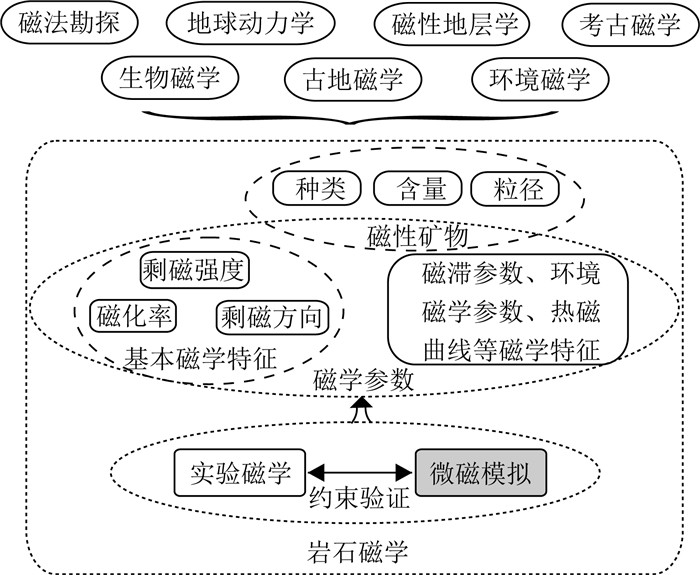
|
图 1 岩石磁学的研究内容及与各磁学学科的关系图 Fig. 1 Rock magnetism and its relationship with the other magnetic subjects |
然而,磁学研究中磁性矿物自身物性因素(种类、形状、大小、相互作用等)对磁信息记录的影响、环境过程对磁性矿物的改造(氧化、还原、熔融、结晶)等核心问题,限制了古地磁学信息的有效提取,制约了人们对地磁场信息的进一步解译(Liu et al., 2011).例如,假单畴(PSD)颗粒的剩磁记录特性、氧化条件下磁性矿物的磁学响应等问题,关系到人们对磁性矿物的地磁场响应及其地球动力学意义的深入认识,需要进一步的研究和澄清(Ge et al., 2014; Almeida et al., 2016).
针对磁性矿物微观行为的进一步探索,微磁模拟方法在近年来逐渐受到重视(Dunlop and Özdemir, 2001).作为一种技术磁化理论,微磁学是考察磁体内磁学性质的实用性研究方法(Brown, 1963).其研究尺度介于原子(自旋)和磁畴(自发磁化区域)之间,从而能以连续的磁化强度矢量,反映磁畴间磁化强度矢量的过渡状态(Fildler and Schrefl, 2000).相比磁畴理论,微磁学的优势在于磁畴和畴壁是计算直接获得的结果,而非初始假设,并能最终给出有场、无场等条件下磁体的磁化状态和能量结构等图像(图 2)(Liu et al., 2012).因此应用微磁模拟计算不同参数下的磁体性质,可以有效地解耦各种参数的影响,正演计算不同岩石矿物的磁学行为特征,弥补了实验岩石磁学对于微观磁学认识的不足(图 1).
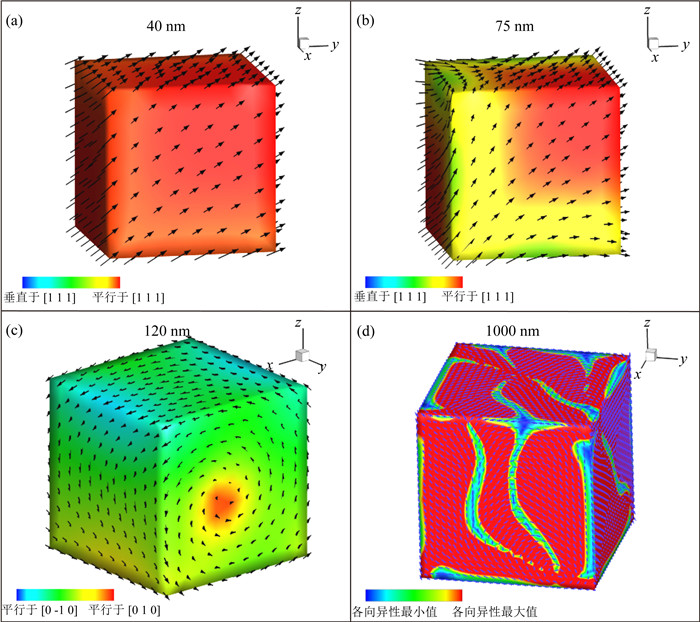
|
图 2 不同粒径磁铁矿的微观磁化结构 (a)一致磁化状态的单畴(uniform SD)结构;(b)花状磁化状态的单畴(flower SD)结构; (c)漩涡磁化状态的假单畴(vortex PSD)结构; (d)多畴磁化(multi-domain, MD)结构.图中黑色箭头为磁化强度矢量,(a—c)中颜色棒表示磁化强度方向的变化,(d)中颜色棒由蓝色到红色表示磁化强度各向异性度由最小变化到最大,显示了畴壁和磁畴结构(修改自Liu et al., 2012). Fig. 2 Micromagnetic structures of magnetite grains with different grain size (a) Uniform structure in a 40 nm magnetite grain; (b) Flower structure in a 75 nm magnetite grain; (c) Vortex structure in a 120 nm magnetite grain; (d) Multi-domain structure in a 1000 nm magnetite grain. Black arrows indicate the directions of magnetization of the meshed elements. Surfaces of magnetite grains are colored, with magnetization aligned perpendicular to [1 1 1] axis being blue and along the [1 1 1] red (Fig. 2(a-b)), with magnetization aligned parallel to [0 -1 0] axis being blue and along the [0 1 0] red (Fig. 2c), and with minimal value of anisotropy being blue and maximal red (Fig. 2d) (revised from Liu et al. 2012). |
在岩石磁学中的应用方面,Williams和Dunlop(1989, 1995)首先给出了磁铁矿磁化强度的三维结构,并计算了六面体的磁滞参数.研究证实了实验观测,即矫顽力(Bc)和饱和剩磁与饱和磁化强度比(Mrs/Ms)与粒径的变化呈反比.通过计算不同形状因子的磁铁矿颗粒剩磁状态,Fabian和Heider(1996)得到了单畴(SD)和假单畴(PSD)颗粒的临界粒径.针对SD颗粒的磁化强度状态,Newell等模拟了单轴各向异性单畴(Uniform SD, USD)颗粒的flower SD和vortex SD状态,对使用Day图预测粒径的可行性进行了探讨(Newell, 2000; Newell and Merrill, 2000).此外,Winklhofer和Muxworthy等使用微磁模拟方法,计算了不同颗粒磁铁矿的阻挡温度、高温稳定性和低温下的磁畴状态(Winklhofer et al., 1997; Muxworthy and Williams, 1999; Muxworthy et al., 2003a).
近期微磁模拟在岩石磁学的应用集中在两个方面.第一,在磁颗粒的复杂物性响应上,通过模拟不同形状磁铁矿颗粒的磁滞回线,发现外形(构型各向异性, configurational anisotropy)因素对Bc和Mrs/Ms的影响不容忽视(Williams et al., 2006; Yu and Tauxe, 2008).随着粒径的增加,外形因素可能会超过磁晶各向异性的影响,最终形成新的磁化方向(Williams et al., 2010).与此同时,Muxworthy和Novosad等学者对磁颗粒间的相互作用及对磁畴状态的影响进行了详细模拟研究(Muxworthy et al., 2003b; Novosad et al., 2005; Witt et al., 2005; Evans et al., 2006; Muxworthy and Williams, 2009; Li et al., 2010).第二,在环境对磁性矿物的改造方面,Ge等(2014)通过微磁模拟方法探讨了低温氧化对磁铁矿磁性记录的影响,指出部分氧化颗粒的核壳耦合作用,论证了氧化特征下磁铁矿记录地磁场的可靠性(Almeida et al., 2016).
因此可以使用微磁模拟方法,并结合实验磁学探讨复杂岩石物性、地质环境改造两大影响磁信息记录的基本问题,从模拟和实验两方面分析岩石或沉积物的载磁机理及其赋存的地质意义.
1 微磁模拟的物理基础 1.1 微磁模拟的静态描述微磁学的主要假设是在温度不变化的情况下,磁化强度矢量M大小保持不变,方向是位置的连续函数.微磁模拟的静态方法即求解吉布斯自由能(magnetic Gibbs′s free energy)最小(Brown, 1963),其能量为

|
(1) |
其中Ee为交换能;Ea为磁晶各向异性能;Em是静磁能,以退磁能Ed为主体;Eh是外场能(Zeeman能);Eσ是磁致伸缩能,其能量较以上能量低约两个量级(Néel, 1949).因此Et可近似简化为(Williams et al., 2010)

|
(2) |
静态方法可以获得体系平衡时的能量状态,但是无法解决以下问题:(1)零场下未处于平衡状态的体系,如何达到平衡状态;(2)时变磁场下磁化强度矢量的响应过程;(3)对于存在局域极小能态的体系,静态方法可能无法平衡于最小能态.
实际上,当磁化强度状态变化时,其遵循Landau-Lifshiz-Gilbert动态方程(Landau and Lifshitz, 1935; Gilbert, 1955)

|
(3) |
其中γ是旋磁比,Heff是有效磁场,α是衰减常数.
微磁模拟的动态方程包括M围绕Heff的自旋进动项和M围绕Heff旋转的阻尼项.体系内部的磁能在足够大的外场下将克服局部极小能态,遵循公式(3)的动力轨迹最终达到最小能态.
1.3 微磁模拟的计算方法在实际计算中通常使用求解自由能最小的静态方法和LLG方程的动态方法相结合的算法(Williams et al., 2011),能够在提高运算速度的同时,保证磁化强度最终达到最小能态.具体步骤即首先对吉布斯自由能进行最小预测(initial guess),然后求解动力学方程,最终得到不同外场状态的磁化结果及相关磁学参数.
2 微磁模拟的研究特色与应用在岩石磁学研究中,常见的铁磁性矿物如磁铁矿、磁赤铁矿、赤铁矿、胶黄铁矿等均可作为地磁场信息的载体(Butler, 1992; Tauxe, 2010).目前对自然界最重要的载磁矿物磁铁矿的模拟研究较为成熟,对同属等轴晶系的磁赤铁矿、胶黄铁矿研究尚少,对属于单斜晶系的赤铁矿模拟尚处于探索之中(Roberts et al., 2011; Muxworthy et al., 2013; 张溪超等, 2013; Ge et al., 2014).
2.1 对颗粒物性的精确约束以磁铁矿为例,早期以宏观磁学特征的理论研究为主(Néel, 1949).研究发现含量、粒径、形状、相互作用、内应力等是影响磁铁矿宏观特性的主要因素(Dunlop and Özdemir, 2001).深入的研究发现磁铁矿的磁学参数受控于体系内磁化强度矢量的特殊排列状态(Muxworthy et al., 2003b; Williams et al., 2006; Yu and Tauxe, 2008; 刘青松和邓成龙, 2009).因此,只有深入研究自然矿物内部磁化强度的排列特征,结合宏观磁学反映,才能进一步解决磁铁矿磁信息记录的机理问题.
2.1.1 预测实验结论针对这一问题,前人主要使用实验磁学方法对磁铁矿的磁性特征进行观测研究(Dunlop and Özdemir, 2001).首先通过合成方法,如微晶玻璃、水热、研磨等方法合成粒径较为均一的磁铁矿(Maher, 1988; Yu et al., 2002; 刘青松等, 2005),然后通过无磁晶体稀释,使用高温退火去除样品内应力,最后进行分类岩石磁学实验,探讨其磁性特征和磁信息记录的可靠性,达到推测天然样品磁学性质的目的.但是使用实验方法无法精确约束磁铁矿的粒径,并且磁颗粒本身的磁吸附性导致合成磁铁矿无法准确模拟自然界中具有分散磁铁矿成分的岩石或沉积物(Yu et al., 2002).特别地,对于古地磁场的主要载体SD-PSD磁铁矿颗粒,因其粒径范围较窄,合成样品的粒径控制相当困难.因此通过使用微磁模拟方法,精确厘定其粒径范围的磁铁矿颗粒特征至关重要.通过模拟不同参数特征的磁铁矿颗粒,研究其微观和宏观磁学特征,可以有效补充实验结论.例如在实验磁学结果框架下,通过补充微磁模拟的数据,验证了磁滞参数与粒径的对数反比关系(图 3).
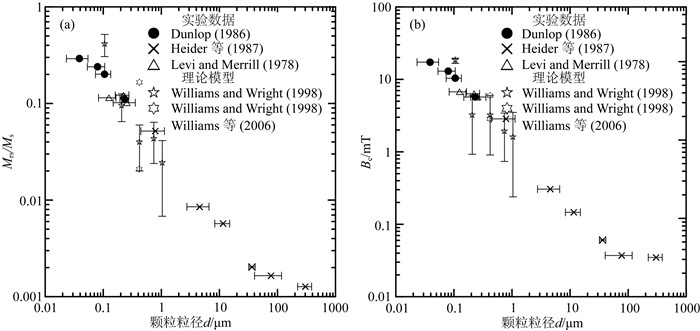
|
图 3 磁铁矿磁滞参数 (a) Mrs/Ms; (b) Bc与颗粒粒径d的相关关系图,实验数据来自无内应力并且充分分散的磁铁矿颗粒,模拟数据来自立方体和八面体磁铁矿颗粒(修改自Williams and Wright, 1998) Fig. 3 The dependences of (a) Mrs/Ms and (b) Bc as a function of grain size The experimental values were collected from unstressed dispersions of magnetite, and the theoretical values were calculated from micromagnetic results of cubic and octahedral magnetite models (revised from Williams and Wright, 1998) |
磁性颗粒的磁化状态不仅依赖于其粒径大小和晶型特征,同样受到磁颗粒间相互作用的影响(Muxworthy and Williams, 2009).天然样品中磁性颗粒物性复杂,难以解耦磁性颗粒相互作用的影响;然而合成磁性颗粒因本身的强磁性聚集效应,难以模拟与颗粒间距相关的相互作用(Yu et al., 2002).通过微磁模拟方法构建磁颗粒数学模型,可以有效避免以上两种问题,因此能够详细研究磁颗粒间的相互作用及其有效作用距离(Muxworthy et al., 2003b; Evans et al., 2006).如图 4所示,使用微磁方法获得了相互作用下磁颗粒的SD/PSD界限,研究发现PSD状态的颗粒在颗粒间强相互作用影响下将处于SD状态,即相互作用使得单畴颗粒的粒径展布变宽.
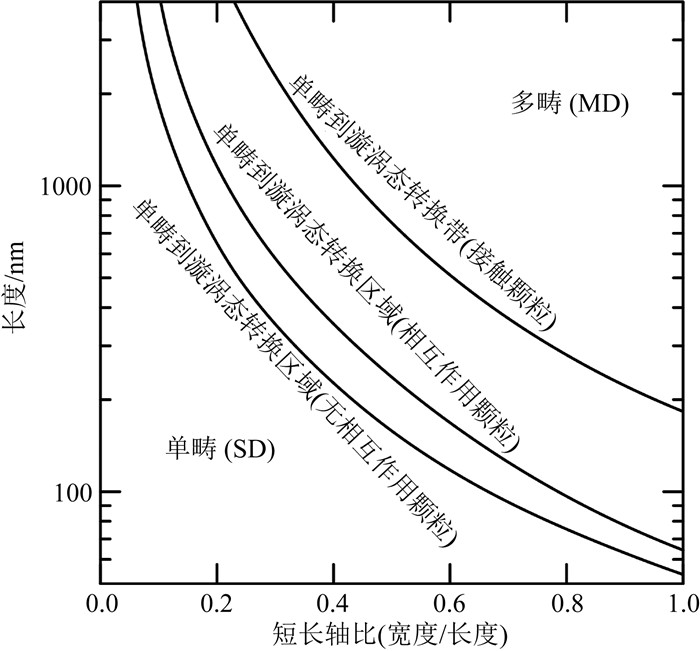
|
图 4 长方体形磁颗粒磁畴状态与粒径、形状和相互作用(颗粒间距)关系图(修改自Muxworthy and Williams, 2006) Fig. 4 Calculated magnetic domain state of magnetic grain with a rectangular shape as a function of particle size, shape factor, and interparticle spacing(revised from Muxworthy and Williams, 2006) |
自然界中磁性矿物因处于不同的环境而形成了形态各异的颗粒,如自生或生物矿化形成不规则或表面粗糙的立方八面体、六角棱柱体颗粒,岩浆岩快速冷却形成的树枝状磁铁矿颗粒等等(图 5(a-b)).这些磁性颗粒混杂于自然样品之中,在一定程度上主导了地磁场的记录(Larson et al., 1969; Gee and Kent, 1995; Li, 2012).由于复杂形态磁性矿物在自然样品中难于进行分离,且实验室合成困难,致使其特殊磁学特征难以被识别.而通过微磁模拟手段,可以对这种复杂形状颗粒进行精细建模和模拟(图 5(c-d)).研究发现对于小颗粒磁铁矿,较小的表面粗糙度会诱导磁化强度矢量成核(nucleate),降低磁场记录的稳定性;而较大的表面粗糙特征将增强颗粒的形状各向异性,提高磁场记录的稳定性.对于树枝型磁铁矿颗粒,颗粒的枝部诱导磁化强度矢量成核,降低了磁场记录的稳定性,而剩磁矢量主要被记录于颗粒的叶状部位(Williams et al., 2010).因此通过微磁模拟能够深入探讨复杂形态磁性颗粒对地磁场记录的可靠性、稳定性以及赋存的地质意义.
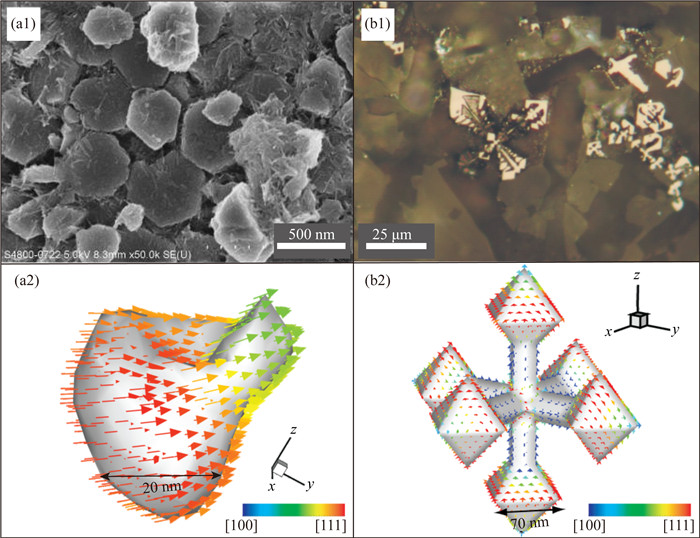
|
图 5 自然界中复杂形状磁性颗粒(a, b)与相关的微磁模拟结构图(a′, b′) (a1)生物矿化形成的不规则六角形和八面体磁铁矿颗粒;(a2)表面不规则形态磁铁矿颗粒模型的微磁模拟结构图;(b1)深海大洋玄武岩中的快速冷凝形成的树枝状磁铁矿颗粒;(b2)树枝状磁铁矿颗粒的微磁模拟结构图.(a2)和(b2)中颜色棒由蓝色到红色表示磁化强度矢量方向的变化,即表示由平行于[100]方向变化到平行于[111]方向(修改自Williams et al., 2010; Li, 2012). Fig. 5 Magnetite grains with irregular morphologies in nature (a1, b1) and their micromagnetic results (a2, b2) (a1) An aggregation of irregular hexagonal and octahedral magnetite crystals; (a2) Micromagnetic result of an irregular magnetite grain; (b1) Skeletal crystals (dendrites) due to supercooling of ocean basalts; (b2) Micromagnetic result of a model dendrite. All micromagnetic structures (a2, b2) share the same color coding, with magnetization of elements aligned parallel with [111] axis being red and along the [100] blue (revised from Williams et al., 2010; Li, 2012). |
基于微磁模拟对复杂颗粒的数值建模优势,通过构建接近自然样品的颗粒集合模型,探索内部磁颗粒内部磁化状态和颗粒间相互作用,同时对比模拟与实验的宏观磁学结果,系统讨论自然样品的磁学特征机制,最终能够清晰地认识岩石或沉积物的磁信息记录机理(Ge and Liu, 2014).
矿物内部磁性颗粒的剩余磁化状态如图 6所示,零场下不同粒径和位置分布的磁颗粒磁化状态差异很大.vortex磁铁矿(图 6a中彩色大颗粒)在毗邻的SD磁铁矿(图 6a中蓝色小颗粒)一侧因具有区域内uniform磁化形态,其相互作用使得小颗粒磁铁矿呈现反向磁化状态.强相互作用下的PSD颗粒会显示uniform磁化形态(图 6b).此外,对于磁铁矿集合中的较大PSD颗粒(图 6c),颗粒间相互作用会使相同颗粒呈现不同的磁化特征,即剩余磁化强度分别沿椭球长轴和短轴形成vortex结构.基于实验观测,微磁模拟构建了8个相同粒径分布,空间分布各异的磁铁矿颗粒集合,统计得到的磁滞回线与实验结果如图 6d所示,模拟结果表现出典型的PSD性质,其磁滞参数,特别是经粒径分布拟合后的结果与实验结果具有较好的一致性.
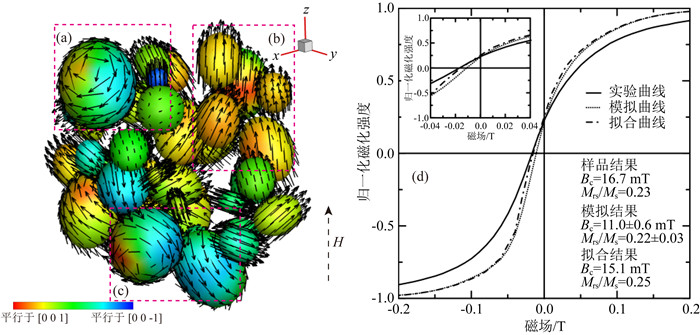
|
图 6 微磁模拟样品内部磁性颗粒的剩磁状态(a—c)及磁滞回线的实验、模拟结果对比图(d) 图中右侧黑色虚线箭头表示初始加场H的方向,颗粒表面黑色箭头代表磁化强度矢量的方向.颜色由红到绿的色度变化表示单元磁化方向由[0 0 1]变化为[0 0 -1].图 6d中实验曲线为具有粒径分布的磁铁矿颗粒集的磁测结果,模拟曲线为依据颗粒分布特征进行微磁模拟获得的磁滞回线,拟合曲线为适度调整粒径分布特征获得的最佳拟合曲线(修改自Ge and Liu, 2014). Fig. 6 Micromagnetic structures of magnetic remanence (a—c) and hysteresis loops (d) for experimental magnetic assembly The initial field H aligns to [0 0 1] (z) axis and arrows on the grains surfaces represent the directions of magnetizations. Magnetization of magnetite grains are colored from red to blue with its directions aligned along the [0 0 1] axis to [0 0 -1]. Experimental curve in Fig. 6d arised from measurement of a distributed magnetite assembly, modeling curve was the micromagnetic result based on the physical parameters of the magnetite assembly, and the micromagnetic fitting curve resulted from the best fit of experimental results by appropriated corrections of physical parameters of the magnetite assembly (revised from Ge and Liu, 2014). |
另一方面,通过合成样品模拟天然样品内部磁铁矿颗粒磁性特征,还存在着不足.只有使用天然磁铁矿集合进行探索,才能真正理解岩石或沉积物中磁信息记录的机制.生物磁小体是研究磁记录机理的理想天然矿物(图 7),鉴于实验中磁小体种类的有限性和趋磁细菌培养上存在的困难(Li et al., 2010),通过对磁小体(链)进行微磁模拟推断其磁学特征显得尤为重要.如通过对单个磁小体的微磁模拟发现,磁小体的圆端具有束缚磁化强度矢量的作用(Witt et al., 2005).进一步的模拟研究发现,磁小体形状对强相互作用下的磁小体链磁学性质影响较小,反之则较大(Novosad et al., 2005).
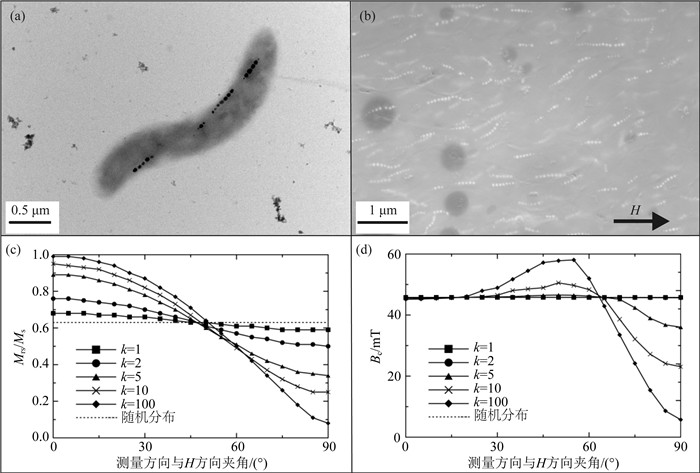
|
图 7 趋磁细菌AMB-1磁小体分布(a—b)及微磁模拟磁小体链集合的磁滞参数结果(c—d) (a)趋磁细菌及磁小体形态的SEM图像;(b)定向磁场下制备的磁小体SEM图像;(c—d)微磁模拟10000条磁小体链在不同定向精度(k)下磁滞参数(Mrs/Ms, Bc)与测量方向的关系,虚线代表随机分布(无定向)磁小体链的磁滞参数模拟结果(修改自Li et al., 2013). Fig. 7 SEM images of magnetotactic bacteria AMB-1 (a—b) and micromagnetic results of hysteresis parameters for magnetosome chains (c—d) (a) Morphologies of magnetotactic bacteria AMB-1 and its magnetsome chains; (b) Oriented magnetosome chains of AMB-1; (c—d) Micromagnetic results of hysteresis parameters (Mrs/Ms, Bc) for 10000 magnetosome subchains as a function of the direction of measurement. The dashed lines represent the magnetic properties of un-oriented (random) magnetosome chains (revised from Li et al., 2013). |
通过对趋磁细菌磁各向异性的模拟与实验研究发现,磁小体链的宏观磁学特征与uniform磁化状态的SD颗粒类似,因此证明了磁小体链是天然剩磁(NRM)的良好载体.模拟显示(图 7),磁滞参数与磁小体链的定向程度相关,在较低的定向程度下Mrs/Ms的各向异性较Bc更大,以上研究为化石磁小体的识别和磁信息的获取提供了依据.
2.2 对颗粒化学变化的精确控制自然界中大多数岩石或沉积物记录原生剩磁之后,在地质历史时期会经历各种化学转化,如氧化还原、出熔等作用.化学改造之下形成新的磁性矿物,其化学剩磁(CRM)与原生剩磁在方向和大小上均有可能产生差异(Özdemir and Dunlop, 1985).
磁铁矿或钛磁铁矿的低温氧化现象常见于玄武岩(van Velzen and Dekkers, 1999)、黄土和古土壤(Liu et al., 2007; Liu et al., 2011)之中,这种长期低温氧化造成了剩磁记录强度和方向上的变化,例如深海玄武岩因为低温氧化而无法携带热剩磁,导致无法从大量海底磁异常条带中准确获取古地磁场信息(Özdemir and Dunlop, 1985).磁学实验观测发现,磁铁矿或磁赤铁矿的低温氧化最终形成一个核壳结构,即包含氧化为新矿物的壳层部分和未经氧化的内核部分,然而实验对于化学转化的精确模拟特别是粒径和化学转化程度的控制上存在困难,无法从实验上进一步确定其微观磁学行为(Cui et al., 1994).
通过微磁建模可以精确控制核壳结构模型,探讨其微观磁学特征.图 8展示了磁铁矿低温氧化的微磁模拟过程.即首先建立研究对象的有限差分模型,然后根据氧化程度比例设置磁铁矿和磁赤铁矿单元参数(饱和磁化强度、磁晶各向异性常数和交换常数),并通过设置交换常数模拟核壳耦合边界,最终模拟核壳模型的整个磁化过程.图 8(c-d)显示了不同氧化程度的核壳模型磁化强度分布结果,随着氧化程度的增加,磁纳米颗粒的磁化强度矢量方向更加一致,然而整体磁化方向仍然指向[111]方向,这说明发生低温氧化的磁铁矿具有可靠的磁场方向记录,由此验证了化学剩磁记录古地磁场方向的可靠性.

|
图 8 磁铁矿低温氧化的微磁模型及模拟结果 (a)微磁模拟的有限差分网格图;(b)部分氧化磁铁矿的微磁学模型:即由被氧化的磁赤铁矿外壳和未被氧化的磁铁矿内核构成的核壳结构;(c)未氧化前粒径80 nm的磁铁矿颗粒微磁结构图,初始外场方向为[111]方向,曲面内为偏离[111]方向20°以内的磁化强度矢量;(d)氧化程度为78%的80 nm磁铁矿颗粒微磁结构图,初始外场方向为[111]方向,曲面内为偏离[111]方向20°以内的磁化强度矢量(修改自Ge et al., 2014). Fig. 8 Frame of reference for micromagnetic modeling of low-temperature oxidized magnetite (a—b) and their zero-field micromagnetic domain structures (c—d) (a) Discretization scheme of the particle; (b) The core-shell model which was built using a cubic skin (brown) and a cubic interior (black), represents the maghemite shell and the magnetite inner core, respectively. Zero-field micromagnetic domain structures of an 80 nm sized grain with oxidation parameter, z, equal to 0 and 0.784 are illustrated in Fig. 8(c—d), respectively. For each model, the sample′s magnetization was saturated along the [111] direction. All structures are colored, with magnetization of elements aligned parallel with the net remanence being red and perpendicular being blue. Translucent isosurfaces are containing all moments lying within 20° of the [111] direction in Fig. 8c and 10° in Fig. 8d, respectively (revised from Ge et al., 2014). |
因此,将微磁模拟方法应用于复杂物性铁磁性矿物和多相铁磁性矿物的磁性记录研究,结合实验磁学能够有效地探索磁性颗粒的物性影响机制和环境改造行为,最终极大地拓展了有效磁学信息的提取,达到系统解释地磁场记录机制的目的.
3 小结与展望微磁模拟能够精确获取特定条件下磁性矿物的宏观磁学性质和微观磁化状态,具有实验方法无法替代的作用.在磁记录的物性影响和环境改造等基础岩石磁学研究中,通过微磁模拟与实验磁学相结合,能够相对定量化地分析、反演磁性矿物的物性特征以及其产生、输运、改造等过程中赋存的构造和环境意义.近年来电子全息术在实验磁学中的应用是岩石磁学的一个重要进展(Harrison and Feinberg, 2009),该方法可以同时对颗粒内部磁化强度和颗粒间相互作用进行二维成像(图 9(a-b)).因此借助电子全息实验的验证,微磁模拟磁颗粒三维磁化结构将有助于更深入地认识磁性颗粒的内部磁学特征(图 9(c-d)).在研究中,同时将微磁模拟与实验磁学、材料科学等学科相结合,将为全面解析岩石或沉积物中的磁性矿物信息提供有力依据.
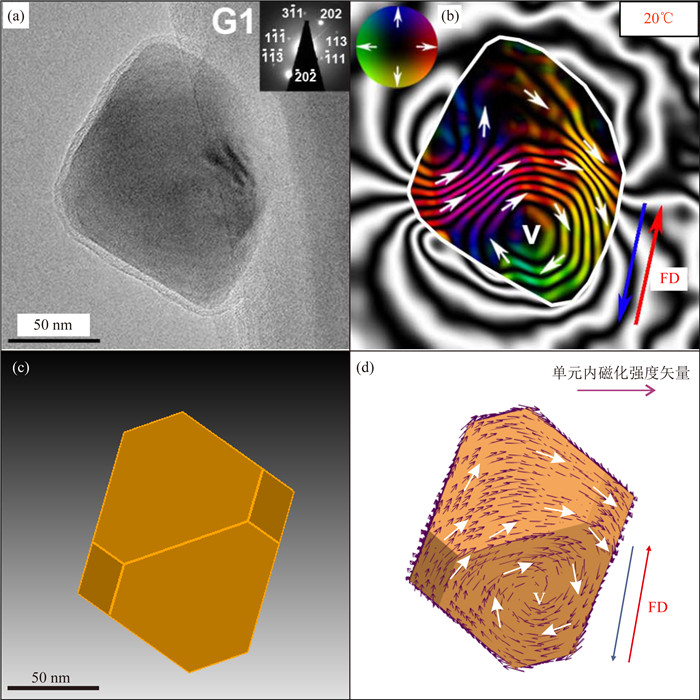
|
图 9 磁铁矿颗粒实验结果(a—b)与对应模型的微磁模拟图像(c—d) (a)磁铁矿颗粒G1的透射电镜(TEM)图像,其中右上角为G1的电子衍射花样图;(b) G1在电子全息照下的磁力线分布状态图,FD为初始外加磁场方向;(c)根据透射电镜图像构建的拉长截角八面体磁铁矿模型;(d)微磁模拟计算的磁铁矿颗粒磁化强度矢量分布结果,FD为初始外加磁场方向. (a—b)修改自Almeida等(2016). Fig. 9 Experimental (a—b) and micromagnetic results (c—d) of a nano-magnetite grain G1 (a) The transmission election microscope (TEM) image of sample G1. The electron diffraction pattern of sample G1 are shown in the top right of the subgraph; (b) Magnetic phase contours of Fig. 9a, measured using electron holography. The original directions of magnetic field are illustrated by FD (Field in red and black arrows); (c) Micromagnetic model of a truncated octahedral magnetite grain depicted in Fig. 9a; (d) Micromagnetic result of the magnetic grain in Fig. 9c. (a-b) are revised from Almeida et al.(2016). |
微磁模拟的研究前沿可以分为两个方向,首先需要继续解答古地磁学和岩石磁学中的一些基本问题,如热剩磁(TRM)、化学剩磁(CRM)和沉积剩磁(DRM)获得过程的模拟研究;另一方面需要拓宽研究对象,改进微磁算法开展MD磁铁矿、胶黄铁矿和赤铁矿等铁磁性矿物的微观磁性探索.具体可以在以下几方面重点开展工作:
(1) PSD颗粒TRM获得机制的研究.岩石或沉积物记录古地磁场的基础是热剩磁的弛豫时间理论,然而该理论仅适用于SD颗粒(Néel, 1949).在自然界中,PSD颗粒是磁信息的主要载体,因此需要对PSD颗粒的TRM获得机制进行系统研究才能从根本上解决地磁场记录的可靠性问题.对于这一问题,在实验观测的支持下,需要将热波动理论引入微磁模拟计算之中,最终得到外场(模拟古地磁场)下磁性颗粒磁化强度的方向和强度的获得过程.
(2) CRM磁场记录过程的深入研究.目前对CRM的磁信息记录模拟研究仅局限于磁铁矿的低温氧化方向,对于其它环境过程下岩石或沉积物获得CRM也缺乏模拟研究(Liu et al., 2014).而且磁铁矿的低温氧化仅仅考虑的高场下部分氧化磁铁矿的磁学行为,对于弱场(地磁场)下CRM的获得过程尚不清楚.对于这一问题,需要在实验数据的有效约束下,实现对多相矿物组分变化下的动态微磁模拟,最终模拟新生矿物CRM的整个获得过程.
(3) 不同铁磁性颗粒集合的微磁模拟和实验研究.在解决了不同矿物种类单一颗粒的剩磁获得过程的基础上,研究的最终目的是模拟岩石或沉积物的剩磁记录行为,即需要获得不同磁性矿物构成的复杂颗粒集合的微观磁学性质.因此需要改进微磁模拟算法,如GPU算法和并行有限元算法(Kakay et al., 2010; Abert et al., 2013),实现对不同铁磁性矿物构成的颗粒集合体的模拟运算.
可以预见,随着微磁模拟算法的发展,结合磁学实验手段的不断更新,未来微磁模拟在岩石磁学的应用研究将更加深入,应用前景将更加广阔.
致谢作者在本文的写作中,与姜兆霞、刘建兴、徐慧茹、王寅炤进行了多次探讨并获益良多,同时两位审稿人对本文的修改提出了宝贵意见和建议,在此一并表示感谢.
Abert C, Exl L, Bruckner F, et al.
2013. Magnum.Fe:A micromagnetic finite-element simulation code based on FEniCS. Journal of Magnetism and Magnetic Materials, 345: 29-35.
DOI:10.1016/j.jmmm.2013.05.051 |
|
Almeida T P, Muxworthy A R, Kovács A, et al.
2016. Direct visualization of the thermomagnetic behavior of pseudo-single-domain magnetite particles. Science Advances, 2(4): e1501801.
DOI:10.1126/sciadv.1501801 |
|
Blakemore R.
1975. Magnetotactic bacteria. Science, 190(4212): 377-379.
DOI:10.1126/science.170679 |
|
Brown W F Jr. 1963.
Micromagnetics. New York: John Wiley & Sons.
|
|
Butler R F. 1992.
Paleomagnetism:Magnetic Domains to Geologic Terranes. Boston: Blackwell Scientific Publications.
|
|
Cui Y L, Verosub K L, Roberts A P.
1994. The effect of low-temperature oxidation on large multi-domain magnetite. Geophysical Research Letters, 21(9): 757-760.
DOI:10.1029/94GL00639 |
|
Dunlop D J, Özdemir Ö. 2001.
Rock Magnetism:Fundamentals and Frontiers. Cambridge: Cambridge University Press.
|
|
Evans M E, Krása D, Williams W, et al.
2006. Magnetostatic interactions in a natural magnetite-ulvöspinel system. Journal of Geophysical Research:Solid Earth, 111(B12): B12S16.
DOI:10.1029/2006JB004454 |
|
Fabian K, Heider F.
1996. How to include magnetostriction in micromagnetic models of titanomagnetite grains. Geophysical Research Letters, 23(20): 2839-2842.
DOI:10.1029/96GL01429 |
|
Fidler J, Schrefl T.
2000. Micromagnetic modelling-the current state of the art. Journal of Physics D:Applied Physics, 33(15): R135-R156.
DOI:10.1088/0022-3727/33/15/201 |
|
Ge K P. 2014. Application research of micromagentic modeling in paleomagentism (in Chinese). Beijing: University of Chinese Academy of Sciences.
|
|
Ge K P, Liu Q S.
2014. Effects of the grain size distribution on magnetic properties of magnetite:constraints from micromagnetic modeling. Chinese Science Bulletin, 59(34): 4763-4773.
DOI:10.1007/s11434-014-0584-z |
|
Ge K P, Williams W, Liu Q S, et al.
2014. Effects of the core-shell structure on the magnetic properties of partially oxidized magnetite grains:experimental and micromagnetic investigations. Geochemistry, Geophysics, Geosystems, 15(5): 2021-2038.
DOI:10.1002/2014GC005265 |
|
Gee J, Kent D V.
1995. Magnetic hysteresis in young mid-ocean ridge basalts:Dominant cubic anisotropy?. Geophysical Research Letters, 22(5): 551-554.
DOI:10.1029/95GL00263 |
|
Gilbert T L.
1955. A Lagrangian formulation of gyromagnetic equation of the magnetization field. Physical Review, 100: 1243.
|
|
Harrison R J, Feinberg J M.
2009. Mineral magnetism:providing new insights into geoscience processes. Elements, 5(4): 209-215.
DOI:10.2113/gselements.5.4.209 |
|
Kakay A, Westphal E, Hertel R.
2010. Speedup of FEM Micromagnetic Simulations With Graphical Processing Units. IEEE Transactions on Magnetics, 46(6): 2303-2306.
DOI:10.1109/TMAG.2010.2048016 |
|
Landau L, Lifshitz E.
1935. On the theory of the dispersion of magnetic permeability in ferromagnetic bodies. Physikalische Zeitschrift der Sowjetunion, 8(153): 101-114.
|
|
Larson E, Ozima M, Ozima M, et al.
1969. Stability of remanent magnetization of igneous rocks. Geophysical Journal International, 17(3): 263-292.
DOI:10.1111/j.1365-246X.1969.tb00237.x |
|
Li J H, Pan Y X, Liu Q S, et al.
2010. Biomineralization, crystallography and magnetic properties of bullet-shaped magnetite magnetosomes in giant rod magnetotactic bacteria. Earth and Planetary Science Letters, 293(3-4): 368-376.
DOI:10.1016/j.epsl.2010.03.007 |
|
Li J H, Ge K P, Pan Y X, et al.
2013. A strong angular dependence of magnetic properties of magnetosome chains:implications for rock magnetism and paleomagnetism. Geochemistry, Geophysics, Geosystems, 14(10): 3887-3907.
DOI:10.1002/ggge.20228 |
|
Li Y L.
2012. Hexagonal platelet-like magnetite as a biosignature of thermophilic iron-reducing bacteria and its applications to the exploration of the modern deep, hot biosphere and the emergence of iron-reducing bacteria in early precambrian oceans. Astrobiology, 12(12): 1100-1108.
DOI:10.1089/ast.2012.0847 |
|
Liu C Y, Ge K P, Zhang C X, et al.
2011. Nature of remagnetization of Lower Triassic red beds in southwestern China. Geophysical Journal International, 187(3): 1237-1249.
DOI:10.1111/gji.2011.187.issue-3 |
|
Liu J X, Shi X F, Ge S L, et al.
2014. Identification of the thick-layer greigite in sediments of the South Yellow Sea and its geological significances. Chinese Science Bulletin, 59(22): 2764-2775.
DOI:10.1007/s11434-014-0166-0 |
|
Liu Q S, Yu Y, Pan Y X, et al.
2005. Partial anhysteretic remanent magnetization (pARM) of synthetic single-and multi-domain magnetites and its paleoenvironmental significance. Chinese Science Bulletin, 50(20): 2381-2384.
DOI:10.1007/BF03183751 |
|
Liu Q S, Deng C L, Torrent J, et al.
2007. Review of recent developments in mineral magnetism of the Chinese loess. Quaternary Science Reviews, 26(3-4): 368-385.
DOI:10.1016/j.quascirev.2006.08.004 |
|
Liu Q S, Deng C L.
2009. Magnetic susceptibility and its environmental significances. Chinese Journal of Geophysics (in Chinese), 52(4): 1041-1048.
DOI:10.3969/j.issn.0001-5733.2009.04.021 |
|
Liu Q S, Roberts A P, Larrasoaña J C, et al.
2012. Environmental magnetism:principles and applications. Reviews of Geophysics, 50(4): RG4002.
DOI:10.1029/2012RG000393 |
|
Maher B A.
1988. Magnetic properties of some synthetic sub-micron magnetites. Geophysical Journal International, 94(1): 83-96.
DOI:10.1111/gji.1988.94.issue-1 |
|
Merrill R T, McElhinny M W. 1983.
The Earth's Magnetic Field:Its History, Origin and Planetary Perspective. London and New York: Academic Press.
|
|
Muxworthy A R, Williams W.
1999. Micromagnetic models of pseudo-single domain grains of magnetite near the Verwey transition. Journal of Geophysical Research:Solid Earth, 104(B12): 29203-29217.
DOI:10.1029/1999JB900294 |
|
Muxworthy A R, Dunlop D J, Williams W.
2003a. High-temperature magnetic stability of small magnetite particles. Journal of Geophysical Research:Solid Earth, 108(B5): 2281.
DOI:10.1029/2002JB002195 |
|
Muxworthy A R, Williams W, Virdee D.
2003b. Effect of magnetostatic interactions on the hysteresis parameters of single-domain and pseudo-single-domain grains. Journal of Geophysical Research:Solid Earth, 108(B11): 2517.
DOI:10.1029/2003JB002588 |
|
Muxworthy A R, Williams W.
2006. Critical single-domain/multidomain grain sizes in noninteracting and interacting elongated magnetite particles:Implications for magnetosomes. Journal of Geophysical Research:Solid Earth, 111(B12): B12S12.
DOI:10.1029/2006JB004588 |
|
Muxworthy A R, Williams W.
2009. Critical superparamagnetic/single-domain grain sizes in interacting magnetite particles:implications for magnetosome crystals. Journal of The Royal Society Interface, 6(41): 1207-1722.
DOI:10.1098/rsif.2008.0462 |
|
Muxworthy A R, Williams W, Roberts A P, et al.
2013. Critical single domain grain sizes in chains of interacting greigite particles:Implications for magnetosome crystals. Geochemistry, Geophysics, Geosystems, 14(12): 5430-5441.
DOI:10.1002/ggge.v14.12 |
|
Néel L.
1949. Théorie du traînage magnétique des ferromagnétiques en grains fins avec applications aux terres cuites. Annual Géophysique, 5(2): 99-136.
|
|
Newell A J.
2000. The Lowrie-Fuller test:single-domain and micromagnetic theory. Earth and Planetary Science Letters, 183(1-2): 335-346.
DOI:10.1016/S0012-821X(00)00271-5 |
|
Newell A J, Merrill R T.
2000. Size dependence of hysteresis properties of small pseudo-single-domain grains. Journal of Geophysical Research:Solid Earth, 105(B8): 19393-19403.
DOI:10.1029/2000JB900122 |
|
Novosad V, Fradin F Y, Roy P E, et al.
2005. Magnetic vortex resonance in patterned ferromagnetic dots. Physical Review B, 72(2): 024455.
DOI:10.1103/PhysRevB.72.024455 |
|
ÖzdemirÖ, DunlopD J.
1985. An experimental study of chemical remanent magnetizations of synthetic monodomain titanomaghemites with initial thermoremanent magnetizations. Journal of Geophysical Research:Solid Earth, 90(B13): 11513–11523.
|
|
Roberts A P, Chang L, Rowan C J, et al.
2011. Magnetic properties of sedimentary greigite (Fe3S4):An update. Reviews of Geophysics, 49(1): RG1002.
DOI:10.1029/2010RG000336 |
|
Stern R J.
2002. Subduction zones. Reviews of Geophysics, 40(4): 3-1-3-38.
|
|
Tarduno J A, Cottrell R D, Watkeys M K, et al.
2007. Geomagnetic field strength 3.2 billion years ago recorded by single silicate crystals. Nature, 446(7136): 657-660.
DOI:10.1038/nature05667 |
|
Tarduno J A, Cottrell R D, Davis W J, et al.
2015. A Hadean to Paleoarchean geodynamo recorded by single zircon crystals. Science, 349(6247): 521-524.
DOI:10.1126/science.aaa9114 |
|
Tauxe L. 2010.
Essentials of Paleomagnetism. Berkeley: University of California Press.
|
|
Thompson R, Oldfield F. 1986.
Environmental Magnetism. London: Allen Unwin.
|
|
Van Velzen A J, Dekkers M J.
1999. Low-temperature oxidation of magnetite in loess-paleosol sequences:a correction of rock magnetic parameters. Studia Geophysica et Geodaetica, 43(4): 357-375.
DOI:10.1023/A:1023278901491 |
|
Williams W, Dunlop D J.
1989. Three-dimensional micromagnetic modelling of ferromagnetic domain structure. Nature, 337(6208): 634-637.
DOI:10.1038/337634a0 |
|
Williams W, Dunlop D J.
1995. Simulation of magnetic hysteresis in pseudo-single-domain grains of magnetite. Journal of Geophysical Research:Solid Earth, 100(B3): 3859-3871.
DOI:10.1029/94JB02878 |
|
Williams W, Wright T M.
1998. High-resolution micromagnetic models of fine grains of magnetite. Journal of Geophysical Research:Solid Earth, 103(B12): 30537-30550.
DOI:10.1029/98JB01120 |
|
Williams W, Muxworthy A R, Paterson G A.
2006. Configurational anisotropy in single-domain and pseudosingle-domain grains of magnetite. Journal of Geophysical Research, 111(B12): B12S13.
DOI:10.1029/2006JB004556 |
|
Williams W, Evans M E, Krása D.
2010. Micromagnetics of paleomagnetically significant mineral grains with complex morphology. Geochemistry Geophysics Geosystems, 11(2): Q02Z14.
DOI:10.1029/2009GC002828 |
|
Williams W, Muxworthy A R, Evans M E.
2011. A micromagnetic investigation of magnetite grains in the form of Platonic polyhedra with surface roughness. Geochemistry Geophysics Geosystems, 121(10): Q10Z31.
DOI:10.1029/2011GC003560 |
|
Winklhofer M, Fabian K, Heider F.
1997. Magnetic blocking temperatures of magnetite calculated with a three-dimensional micromagnetic model. Journal of Geophysical Research:Solid Earth, 102(B10): 22695-22709.
DOI:10.1029/97JB01730 |
|
Witt A, Fabian K, Bleil U.
2005. Three-dimensional micromagnetic calculations for naturally shaped magnetite:octahedra and magnetosomes. Earth and Planetary Science Letters, 233(3-4): 311-324.
DOI:10.1016/j.epsl.2005.01.043 |
|
Yu Y, Dunlop D J, Özdemir Ö.
2002. Partial anhysteretic remanent magnetization in magnetite 1.Additivity. Journal of Geophysical Research:Solid Earth, 107(B10): EPM 7-1-EPM 7-9.
DOI:10.1029/2001JB001249 |
|
Yu Y, Tauxe L.
2008. Micromagnetic models of the effect of particle shape on magnetic hysteresis. Physics of the Earth and Planetary Interiors, 169(1-4): 92-99.
DOI:10.1016/j.pepi.2008.07.006 |
|
Zhang X C, Zhao G P, Xia J.
2013. Micromagnetic analysis of the maghemite platelet chains in the iron-mineral-based magnetoreceptor of birds. Acta Physica Sinica (in Chinese), 62(21): 218702.
|
|
Zhu G K. 2005.
Basic, Principle, Methods, Achievements and Applications of Paleomagnetism (in Chinese). Beijing: Science Press.
|
|
Zhu R X, Pan Y X, Shaw J, et al.
2001. Geomagnetic palaeointensity just prior to the Cretaceous normal superchron. Physics of the Earth and Planetary Interiors, 128(1-4): 207-222.
DOI:10.1016/S0031-9201(01)00287-4 |
|
葛坤朋. 2014. 微磁模拟在古地磁学中的应用研究. 北京: 中国科学院大学.
|
|
刘青松, YuY, 潘永信, 等.
2005. 单畴和多畴磁铁矿合成样品的部分非磁滞剩磁研究. 科学通报, 50(20): 2267–2270.
DOI:10.3321/j.issn:0023-074X.2005.20.015 |
|
刘青松, 邓成龙.
2009. 磁化率及其环境意义. 地球物理学报, 52(4): 1041–1048.
DOI:10.3969/j.issn.0001-5733.2009.04.021 |
|
张溪超, 赵国平, 夏静.
2013. 鸟类铁矿物磁受体中磁赤铁矿片晶链的微磁学分析. 物理学报, 62(21): 218702.
DOI:10.7498/aps.62.218702 |
|
朱岗崑. 2005.
古地磁学——基础、原理、方法、成果与应用. 北京: 科学出版社.
|
|
 2018, Vol. 61
2018, Vol. 61

